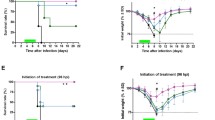Abstract
Although chemotherapy is generally indicated for treatment of enterovirus infections, antivirals are currently not used in clinical practice. The use of monotherapy is the main reason for this unfavourable state. This is related to the fact that enterovirus progeny consist of innumerable quasispecies, allowing the virus to develop drug resistance quickly. Here, we present a consecutive alternating administration (CAA) treatment scheme for combining enterovirus inhibitors. Applying the CAA approach with a combination of pleconaril (capsid binder), guanidine HCl (viral 2C inhibitor), and oxoglaucine (PI4KB inhibitor) (PGO) was found to be effective in the treatment of newborn mice infected with a massive inoculum (20 MLD50) of the coxsackievirus B3 cardiotropic Woodruff or neurotropic Nancy strain. In addition to preventing drug resistance, the CAA approach resulted in the parallel development of increased susceptibility to the compounds in the PGO combination. These observations demonstrate the therapeutic potential of the CAA approach for treatment of enterovirus infections.

Similar content being viewed by others
References
Morens DM, Pallansch MA (1995) Epidemiology. In: Rotbart HA (ed) Human enterovirus infections. ASM Press, Washington, DC, pp 3–23
Pallansch M, Roos R (2005) Enteroviruses: polioviruses, coxsackieviruses, echoviruses and newer enteroviruses. In: Knipe DM, Howley P, Griffin DE et al. (eds) Fields Virology. Vol 1, 5th edn. Lippincott Williams & Wilkins, Philadelphia, PA, pp 839–894.
Galabov AS, Nikolaeva-Glomb L, Nikolova I, Vassileva-Pencheva R (2012) Perspectives for effective chemotherapy of enterovirus infections. In: Najdenski H, Angelova M, Stoitsova S (eds) New Trends of Microbiology (65th Anniversary of the Stephan Angeloff Institute of Microbiology). The Stephan Angeloff Institute of Microbiology, Bulgarian Academy of Sciences, Sofia, pp 47–81
Melnick JL, Crowther D, Barrera-Oro J (1961) Rapid development of drug-resistant mutants of poliovirus. Science 134:557
Nikolova I, Petkova R, Galabov AS, Chakarov S, Atanasov B (2011) Disoxaril mutants of coxsackievirus B1: phenotypic characteristics and analysis of the target VP1 gene. Z Naturforschung 66c:627–636.
Domingo E, Martin V, Perales C, Escarmis C (2008) Coxsackie viruses and quasi species theory: evolution of enteroviruses. Curr Top Microbiol Immunol 323:3–32
Nikolaeva-Glomb L, Galabov AS (2004) Synergistic drug combinations against the in vitro replication of coxsackievirus B1. Antiviral Res 64:9–19
Vassileva-Pencheva R, Galabov AS (2010) Avoiding drug-resistance development by novel approach of combining enteroviral substances against coxsackievirus B1 infection in mice. Antivir Res 85:366–372
Stoyanova A, Nikolova I, Galabov AS (2015) Effect of consecutive alternating administration (CAA) of a triple anti-enteroviral combination on coxsackievirus B1 neuroinfection in mice. Antiviral Res 121:138–144
Stoyanova A, Nikolova I, Pürstinger G, Dobrikov G, Dimitrov V, Philipov S, Galabov AS (2015) Anti-enterovirus triple combination of viral replication inhibitors: activity against coxsackievirus B1 neuroinfection in mice. Antivir Chem Chemother 24:136–147
Galabov AS, Stoyanova A (2016) Consecutive alternating administration of antiviral combinations: a novel treatment approach against coxsackievirus B1 neuroinfection. J Antivir Antiretrovir 8:48–53
Vassileva-Pencheva R, Galabov AS (2016) Effectiveness of the consecutive alternative administration course of a triple combination in coxsackievirus B3 infections in mice. Drug Res 16:1–5
Pevear DC, Tull TM, Seipel ME, Groarke JM (1999) Activity of pleconaril against enterovi-ruses. Antimicrob Agents Chem 43:2109–2115
Herrmann EC Jr, Herrmann JA, Delong DC (1982) Prevention of dead in mice infected with coxsackievirus A6 using guanidine. HCl mixed with substituted benzimidazoles. Antivir Res 2:339–346
Reed L, Muench H (1938) A simple method of estimating 50% endpoints. Amer J Hygiene 27:493–497
Zhang C, Chen Y, Ben K (2003) An improved microtiter assay for evaluating anti-HIV-1 neutralizing antibodies from sera or plasma. BMC Infec Dis 3:30–35
Mosmann T (1983) Rapid colorimetric assay for cellular growth and survival: application to proliferation and cytotoxicity assays. J Immunol Methods 65:55–63
Schmidtke M, Hammerschmidt E, Schüler S, Zell R, Birch-Hirschfeld E, Makarov VA, Riabova OB, Wutzler P (2005) Susceptibility of coxsackievirus B3 laboratory strains and clinical isolates to the capsid function inhibitor pleconaril: antiviral studies with virus chimeras demonstrate the crucial role of amino acid 1092 in treatment. J Antimicrob Chemother 56:648–656
Schmidtke M, Wutzler P, Zieger R, Riabova OB, Makarov VA (2009) New pleconaril and [(biphenyloxy)propyl]isoxazole derivatives with substitutions in the central ring exhibit antiviral activity against pleconaril-resistant coxsackievirus B3. Antivir Res 81:56–63
Kuzmanov BA, Philipov SA, Deligiozova-Gegova IB (1998) Comparative photochemical and chemosystematic research of population of Glaucinum flavum Cranz in Bulgaria. Fitologia 43:52–57
Arita M, Philipov S, Galabov AS (2015) Phosphatidylinositol 4-kinase III beta is the target of oxoglaucine and pachydipol (Ro 09-0179) for their anti-poliovirus activity, and locates at upstream of the target step of brefeldin A in poliovirus replication. Microbiol Immunol 59:338–347
Grozdanov P, Joffret M-L, Stoyanova A, Polston P, Achouri E, Nikolova I, Delpeyroux F, Galabov AS (2020) Genome analysis of coxsackievirus B1 isolates during the consecutive alternating administration course of triple antiviral combination in newborn mice. Antivir Chem Chemother 28:1–6
Funding
This study was funded by the Bulgarian Academy of Sciences according to the National Program “Young Scientists” (grant number DFNP-56).
Author information
Authors and Affiliations
Corresponding author
Ethics declarations
Conflicts of interest
The authors declare that they have no known competing financial interests or personal relationships that could have appeared to influence the work reported in this paper.
Ethical approval
This article does not contain any studies with human participants performed by any of the authors. All applicable institutional and/or national guidelines for the care and use of animals were followed. Animal breeding and experiments were conducted in accordance with the guidelines of Bulgaria’s Directorate of Health Prevention and Humane Behaviour towards Animals and European Communities Council Directives 86/609/ EEC.
Additional information
Handling Editor: Akbar Dastjerdi.
Publisher's Note
Springer Nature remains neutral with regard to jurisdictional claims in published maps and institutional affiliations.
Rights and permissions
About this article
Cite this article
Stoyanova, A., Galabov, A.S. Consecutive alternating administration as an effective anti-coxsackievirus B3 in vivo treatment scheme. Arch Virol 166, 1869–1875 (2021). https://doi.org/10.1007/s00705-021-05057-3
Received:
Accepted:
Published:
Issue Date:
DOI: https://doi.org/10.1007/s00705-021-05057-3




